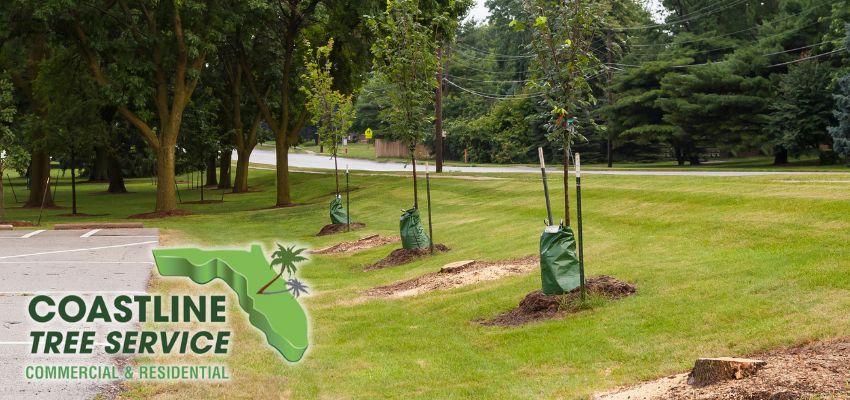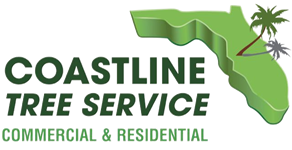
Stabilizing Newly Planted Trees: A Look at Palm and Pine Trees in SW Florida
For an HOA in Southwest Florida, the board & its members shoulder the challenging responsibility of overseeing all aspects of their community. One critical aspect of this task is knowing how long to keep wooden braces on newly planted trees. These supports are crucial for tree stability during the early growth stages, but they must be removed at the appropriate time to allow for robust development. Effectively managing this process requires a well-thought-out tree management strategy. This plan not only ensures the longevity of the landscape but also contributes to the aesthetic appeal of the community. Having the right tree service partner is vital to the success of this plan.
Let’s delve into this topic.
Planting a tree is more than just digging a hole and placing the sapling. It’s about ensuring the tree’s healthy growth and longevity, particularly in SW Florida where weather conditions can be unpredictable.
But how long should a tree, specifically a palm or pine, have wooden braces and beams supporting it when first planted?
Palm trees are a ubiquitous sight in the greater SW Florida areas, adding a tropical ambiance that’s synonymous with the state’s identity. When newly planted, these trees often require bracing to provide stability until their root systems are established enough to support their weight.
The Question Then Arises – “How Long Should These Tree Braces Stay In Place?”
Typically, the bracing on a palm tree should remain for about a year. This period allows the tree to establish its roots and gain the strength it needs to stand on its own. However, this timeframe isn’t set in stone. Factors such as the tree’s rate of growth, the soil condition, and the local climate can influence how quickly a palm tree stabilizes. For instance, some palm varieties grow quite quickly, while others may take years to reach their mature height and width.
Now, let’s switch gears to pine trees. These trees are also common in SW Florida and have different needs from palm trees. When a pine tree is first planted, it may also require staking and bracing for support. The timeframe for this support varies based on the tree’s growth rate and other environmental factors. Generally speaking, a spring-planted tree could be ready to stand without support by fall of the same year, which equates to about six months.
One crucial aspect to remember is that bracing should not be left on a tree longer than necessary. Over time, reliance on braces can inhibit a tree’s natural movement, leading to a weaker trunk and root system. Therefore, it’s crucial to monitor the tree’s development and remove the braces when it’s strong enough to support itself.
The type of bracing used also plays a part in the tree’s growth. Wooden bracing is often recommended for palm trees during their grow-in period. These braces can range in size from three to four pressure-treated lumber pieces, providing sturdy support without damaging the tree.
However, it’s important to remember that these timelines aren’t set in stone. Each tree is unique and may require adjustments based on its growth rate and health. Over-reliance on braces can inhibit a tree’s natural movement, resulting in a weaker trunk and root system. Therefore, it’s crucial to monitor each tree’s development and remove the braces when it’s strong enough to support itself. For this reason as mentioned earlier, it is key to have a reliable tree service partner and tree management plan in place.
Planning For The Next Phase Of Your Newly Planted Trees
Here at Coastline Tree Service, we can help you develop a comprehensive tree management plan plan that outlines the types of trees in the community, their planting dates, and the expected timeframe for brace removal.
We can provide valuable advice on the best practices for supporting newly planted trees as we have the expertise to assess each tree’s stability and determine when it’s appropriate to remove the braces. It’s also important to have regularly scheduled check ups in place to monitor the trees’ health and growth.
Moreover, we can work with your HOA staff or volunteers on how to correctly install and remove wooden braces. This knowledge transfer ensures that the community can independently handle minor tree care tasks while relying on our tree service experts for more complex issues.
In addition, we can guide your HOA in selecting the right trees for your community. Factors such as local climate, soil type, and maintenance requirements should be considered when choosing tree species. For instance, some palm varieties grow quickly while others take years to reach their mature size.
Lastly, it’s crucial for your HOA to communicate with residents about the importance of tree braces and the plan for their removal. This clear communication prevents misunderstandings and fosters a sense of shared responsibility for the community’s green spaces.
So, the next time your HOA is looking to plant a tree or a set of trees within its community, remember that your job doesn’t end when the sapling is in the ground. It continues with appropriately supporting the tree until it can stand tall on its own, a testament to your care and commitment to its growth.
Is Your HOA In Need Of Tree Bracing & Management Services?
If so, then we are here ready to help! We have the equipment, man power, and on staff expertise (certified arborists & tree experts) to handle all of your tree cabling & bracing needs including all tree trimming, tree removal, tree pruning, root pruning & tree stump removal services to name a few.
We proudly serve and offer tree trimming services in Naples, Marco Island, Bonita Springs, Estero, Fort Myers, Fort Myers Beach, North Fort Myers, Cape Coral, Sanibel & Punta Gorda.
Give us a Call at: (239) 895-3230 or contact us online at:https://www.coastlinetree.com/contact-us/
